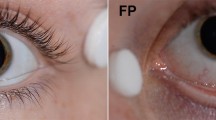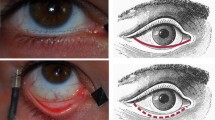Abstract
Electroretinography is commonly used to assess the functional integrity of the retina. There are many external variables that can influence the electroretinographic waveforms recorded, and it is important to be aware of these so as not to misinterpret their effects as abnormalities in retinal function. In this study we examined the effect of three different recording electrodes on the ERGs recorded from normal dogs. A bipolar Burian–Allen lens, a monopolar Dawson Trick Litzkow (DTL) fiber electrode, and a monopolar ERG-Jet lens electrode were compared. The effect of altering the distance of the reference electrode from the eye was also examined; using the ERG-Jet lens electrode, the ERG was recorded with the reference electrode placed over the zygomatic arch at 1, 3 and 5 cm caudal to the lateral canthus. The ERGs recorded with the bipolar Burian–Allen lens had significantly lower amplitudes, higher a-wave thresholds and a shallower initial a-wave slope, than those recorded by the two monopolar electrodes. Positioning the reference electrode further from the eye resulted in significantly higher amplitudes. Naka-Rushton fitting and calculation of retinal sensitivity (K) gave significantly different results between the Burian–Allen lens and ERG-Jet lens electrode with the reference electrode 5 cm from the lateral canthus. These results demonstrate that recording electrode type and distance of the reference electrode from the eye significantly affect the ERG tracings of the dog, and may alter the assessment of retinal function that can therefore be derived. Results obtained using these three different types of electrodes cannot be directly compared.
Similar content being viewed by others
References
R Ofri (2002) ArticleTitleClinical electrophysiology in veterinary ophthalmology – the past, present and future Doc Ophthalmol 104 5–16 Occurrence Handle11949808 Occurrence Handle10.1023/A:1014463514302
A Woerdt ParticleVan der MP Nasisse MG Davidson (1991) ArticleTitleSudden acquired retinal degeneration in the dog: Clinical and laboratory findings in 36 cases Prog Vet Comp Ophthalmol 1 11–8
LF Rubin (1967) ArticleTitleClinical electroretinography in dogs J Am Vet Med Assoc 151 1456–69
MP Nasisse MG Davidson (1999) Surgery of the lens KN Gelatt (Eds) Lippincott EditionNumber3 Williams and Wilkins Philadelphia 827–56
GM Acland GD Aguirre J Ray Q Zhang TS Aleman AV Cideciyan SE Pearce-Kelling V Anand Y Zeng AM Maguire SG Jacobson WW Hauswirth J Bennett (2001) ArticleTitleGene therapy restores vision in a canine model of childhood blindness Nat Genet 28 92–5 Occurrence Handle1:CAS:528:DC%2BD3MXjt1ajsr0%3D Occurrence Handle11326284 Occurrence Handle10.1038/88327
K Narfström ML Katz R Bragadottir M Seeliger A Boulanger TM Redmond L Caro CM Lai PE Rakoczy (2003) ArticleTitleFunctional and structural recovery of the retina after gene therapy in the RPE65 null mutation dog Invest Ophthalmol Vis Sci 44 1663–72 Occurrence Handle12657607
SM Petersen-Jones (1998) ArticleTitleAnimal models of human retinal dystrophies Eye 12 IssueIDPt 3b 566–70 Occurrence Handle9775218
SM Petersen-Jones NW Khan N Tuntivanich (2003) ArticleTitleElectroretinographic features of the PDE6a mutant dog Invest Ophthalmol Vis Sci [ARVO Abstract] 44 4537
GM Acland GD Aguirre (1987) ArticleTitleRetinal degenerations in the dog: IV Early retinal degeneration (erd) in the Norwegian elkhound Exp Eye Res 44 491–521 Occurrence Handle1:STN:280:BiiB2cjgtFE%3D Occurrence Handle3496233
MW Hankins RJ Jones KH Ruddock (1998) ArticleTitleDiurnal variation in the b-wave implicit time of the human electroretinogram Vis Neurosci 15 55–67 Occurrence Handle1:STN:280:DyaK1c7hslKhsw%3D%3D Occurrence Handle9456505 Occurrence Handle10.1017/S0952523898151118
A Mizota E chi-Usami (2002) ArticleTitleEffect of body temperature on electroretinogram of mice Invest Ophthalmol Vis Sci 43 3754–7 Occurrence Handle12454047
GA Fishman (2001) The Electroretinogram GA Fishman DG Birch GE Holder M Brigell (Eds) Electrophysiological testing in disorders of the retina, optic nerve, and visual pathways EditionNumber2 The Foundation of the American Academy of Ophthalmology San Francisco 1–155
Tuntivanich N, Mentzer AL, Eifler D, Montiani-Ferreira F, Forcier JQ, Johnson A, Petersen-Jones SM. Assesment of the dark-adaptation time required for recovery of electroretinographic responses in dogs after fundus photography and indirect ophthalmoscopy. Am J Vet Res 2005 In press
J Yanase H Ogawa (1997) ArticleTitleEffects of halothane and sevoflurane on the electroretinogram of dogs Am J Vet Res 58 904–9 Occurrence Handle1:CAS:528:DyaK2sXls1Srt7Y%3D Occurrence Handle9256979
B Kommonen U Karhunen C Raitta (1988) ArticleTitleEffects of thiopentone halothane-nitrous oxide anaesthesia compared to ketamine-xylazine anaesthesia on the DC recorded dog electroretinogram Acta Vet Scand 29 23–33 Occurrence Handle1:CAS:528:DyaL1MXhvVCiuw%3D%3D Occurrence Handle3202057
R Granit (1933) ArticleTitleThe components of the retinal action potential and their relation to the discharge in the optic nerve J Physiol 77 207–40
AU Bayer T Mittag P Cook SE Brodie SM Podos KP Maag (1999) ArticleTitleComparisons of the amplitude size and the reproducibility of three different electrodes to record the corneal flash electroretinogram in rodents Doc Ophthalmol 98 233–46 Occurrence Handle1:STN:280:DC%2BD3cvhtF2jtQ%3D%3D Occurrence Handle10945443 Occurrence Handle10.1023/A:1002416918247
H Yin MT Pardue (2004) ArticleTitlePerformance of the DTL electrode compared to the jet contact lens electrode in clinical testing Doc Ophthalmol 108 77–86 Occurrence Handle15104170 Occurrence Handle10.1023/B:DOOP.0000018395.78512.4e
WW Dawson GL Trick TM Maida (1982) ArticleTitleEvaluation of the DTL corneal electrode Doc Ophthalmol Proc Ser 31 81–8
MP Hennessy Vaegan (1995) ArticleTitleAmplitude scaling relationships of Burian–Allen, gold foil and Dawson, Trick and Litzkow electrodes Doc Ophthalmol 89 235–48 Occurrence Handle1:STN:280:BymD2MzmvVc%3D Occurrence Handle7555591 Occurrence Handle10.1007/BF01203377
L Esakowitz A Kriss F Shawkat (1993) ArticleTitleA comparison of flash electroretinograms recorded from Burian Allen, JET, C-glide, gold foil, DTL and skin electrodes Eye 7 IssueIDPt 1 169–71 Occurrence Handle8325411
JE Steiss DP Storrs JC Wright (1992) ArticleTitleComparison of electroretinograms recorded with a contact lens versus needle electrode in clinically normal dogs Prog Vet Comp Ophthalmol 2 143–6
M Kuze Y Uji (2000) ArticleTitleComparison between Dawson, Trick, and Litzkow electrode and contact lens electrodes used in clinical electroretinography Jpn J Ophthalmol 44 374–80 Occurrence Handle1:STN:280:DC%2BD3M%2FjtlSktw%3D%3D Occurrence Handle10974293 Occurrence Handle10.1016/S0021-5155(00)00177-5
PA Sieving GA Fishman JM Maggiano (1978) ArticleTitleCorneal wick electrode for recording bright flash electroretinograms and early receptor potentials Arch Ophthalmol 96 899–900 Occurrence Handle1:STN:280:CSeC1cnislc%3D Occurrence Handle655931
SG Coupland M Janaky (1989) ArticleTitleERG electrode in pediatric patients: comparison of DTL fiber, PVA-gel, and non-corneal skin electrodes Doc Ophthalmol 71 427–33 Occurrence Handle1:STN:280:By%2BD3cvosFQ%3D Occurrence Handle2791850 Occurrence Handle10.1007/BF00152771
N Mohidin MK Yap RJ Jacobs (1997) ArticleTitleThe repeatability and variability of the multifocal electroretinogram for four different electrodes Ophthalmic Physiol Opt 17 530–5 Occurrence Handle1:STN:280:DyaK1czjtFGmsQ%3D%3D Occurrence Handle9666928 Occurrence Handle10.1016/S0275-5408(97)00034-3
HM Burian L Allen (1954) ArticleTitleA speculum contact lens electrode for electroretinography Electroencephalogr Clin Neurophysiol Suppl 6 509–11
PA Grounauer (1982) ArticleTitleThe new single use ERG corneal lens electrode and its clinical application Doc Ophthalmol Proc Ser 31 89–93
T Lawwill HM Burian (1966) ArticleTitleA modification of the Burian–Allen contact-lens electrode for human electroretinography Am J Ophthalmol 61 1506–9 Occurrence Handle1:STN:280:CCmC2M%2FivVA%3D Occurrence Handle5938319
GB Arden RM Carter C Hogg IM Siegel S Margolis (1979) ArticleTitleA gold foil electrode: extending the horizons for clinical electroretinography Invest Ophthalmol Vis Sci 18 421–6 Occurrence Handle1:STN:280:CSaC2M%2FivFc%3D Occurrence Handle311765
WW Dawson GL Trick CA Litzkow (1979) ArticleTitleImproved electrode for electroretinography Invest Ophthalmol Vis Sci 18 988–91 Occurrence Handle1:STN:280:Bi%2BD3cros1Q%3D Occurrence Handle478786
KI Naka WA Rushton (1966) ArticleTitleS-potentials from colour units in the retina of fish (Cyprinidae) J Physiol 185 536–55 Occurrence Handle1:STN:280:CCiD3MrislM%3D Occurrence Handle5918058
LS Evans NS Peachey AL Marchese (1993) ArticleTitleComparison of three methods of estimating the parameters of the Naka-Rushton equation Doc Ophthalmol 84 19–30 Occurrence Handle1:STN:280:ByuD3sfkvFA%3D Occurrence Handle8223107 Occurrence Handle10.1007/BF01203279
AU Bayer P Cook SE Brodie KP Maag T Mittag (2001) ArticleTitleEvaluation of different recording parameters to establish a standard for flash electroretinography in rodents Vision Res 41 2173–85 Occurrence Handle1:STN:280:DC%2BD3Mzpsl2hsQ%3D%3D Occurrence Handle11448710 Occurrence Handle10.1016/S0042-6989(01)00103-1
A Kriss (1994) ArticleTitleSkin ERGs: their effectiveness in paediatric visual assessment, confounding factors, and comparison with ERGs recorded using various types of corneal electrode Int J Psychophysiol 16 137–46 Occurrence Handle1:STN:280:ByuA2srjsVA%3D Occurrence Handle8089032 Occurrence Handle10.1016/0167-8760(89)90040-8
SJ Cringle VA Alder MJ Brown DY Yu (1986) ArticleTitleEffect of scleral recording location on ERG amplitude Curr Eye Res 5 959–65 Occurrence Handle1:STN:280:BiiC3cvjsVA%3D Occurrence Handle3802897
TA d’Amato IB Kaplan LD Britt (1994) ArticleTitleHigh-voltage electrical injury: a role for mandatory exploration of deep muscle compartments J Natl Med Assoc 86 535–7 Occurrence Handle1:STN:280:ByuA2czlvVM%3D Occurrence Handle8064905
DC Hood DG Birch (1996) ArticleTitleAssessing abnormal rod photoreceptor activity with the awave of the electroretinogram: applications and methods Doc Ophthalmol 92 253–67 Occurrence Handle9476593
DC Hood DG Birch (1993) ArticleTitleHuman cone receptor activity: the leading edge of the awave and models of receptor activity Vis Neurosci 10 857–71 Occurrence Handle1:STN:280:ByuD3s7psVM%3D Occurrence Handle8217936
P Lachapelle J Benoit JM Little B Lachapelle (1993) ArticleTitleRecording the oscillatory potentials of the electroretinogram with the DTL electrode Doc Ophthalmol 83 119–30 Occurrence Handle1:STN:280:ByyA38jmslw%3D Occurrence Handle8334927 Occurrence Handle10.1007/BF01206210
MF Marmor E Zrenner (1999) ArticleTitleStandard for clinical electroretinography (1999 update). International Society for Clinical Electrophysiology of Vision Doc Ophthalmol 97 143–56 Occurrence Handle1:STN:280:DC%2BD3c3islSgtw%3D%3D Occurrence Handle10.1023/A:1002192829817
K Narfström B Ekesten SG Rosolen BM Spiess CL Percicot R Ofri (2002) ArticleTitleGuidelines for clinical electroretinography in the dog Doc Ophthalmol 105 83–92 Occurrence Handle12462438 Occurrence Handle10.1023/A:1020524305726
AC Kooijman (1986) ArticleTitleThe homogeneity of the retinal illumination is restricted by some ERG lenses Invest Ophthalmol Vis Sci 27 372–7 Occurrence Handle1:STN:280:BimC3sfpvVw%3D Occurrence Handle3949465
Author information
Authors and Affiliations
Corresponding author
Rights and permissions
About this article
Cite this article
Mentzer, A.E., Eifler, D.M., Montiani-Ferreira, F. et al. Influence of Recording Electrode Type and Reference Electrode Position on the Canine Electroretinogram. Doc Ophthalmol 111, 95–106 (2005). https://doi.org/10.1007/s10633-005-4517-7
Accepted:
Published:
Issue Date:
DOI: https://doi.org/10.1007/s10633-005-4517-7




